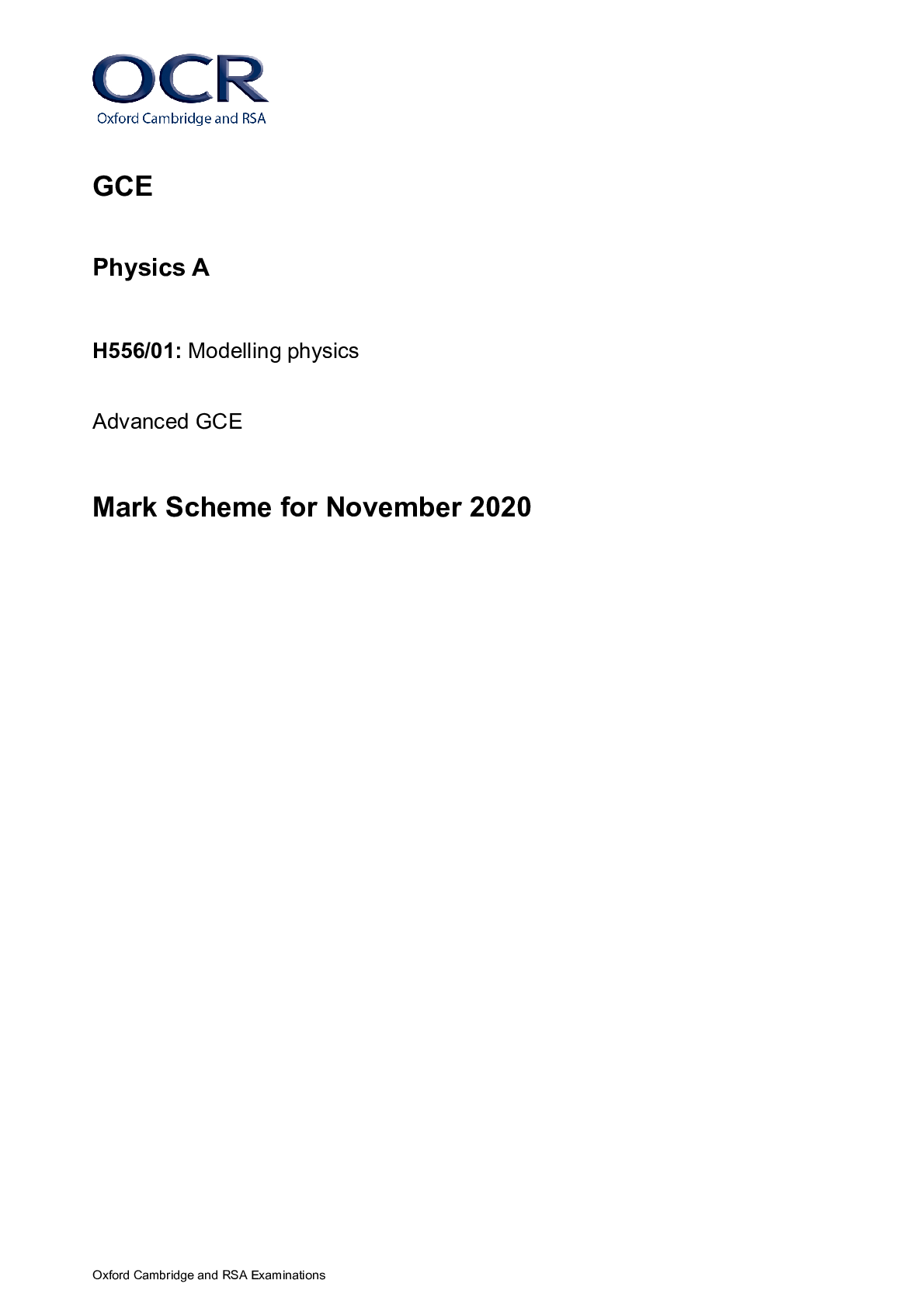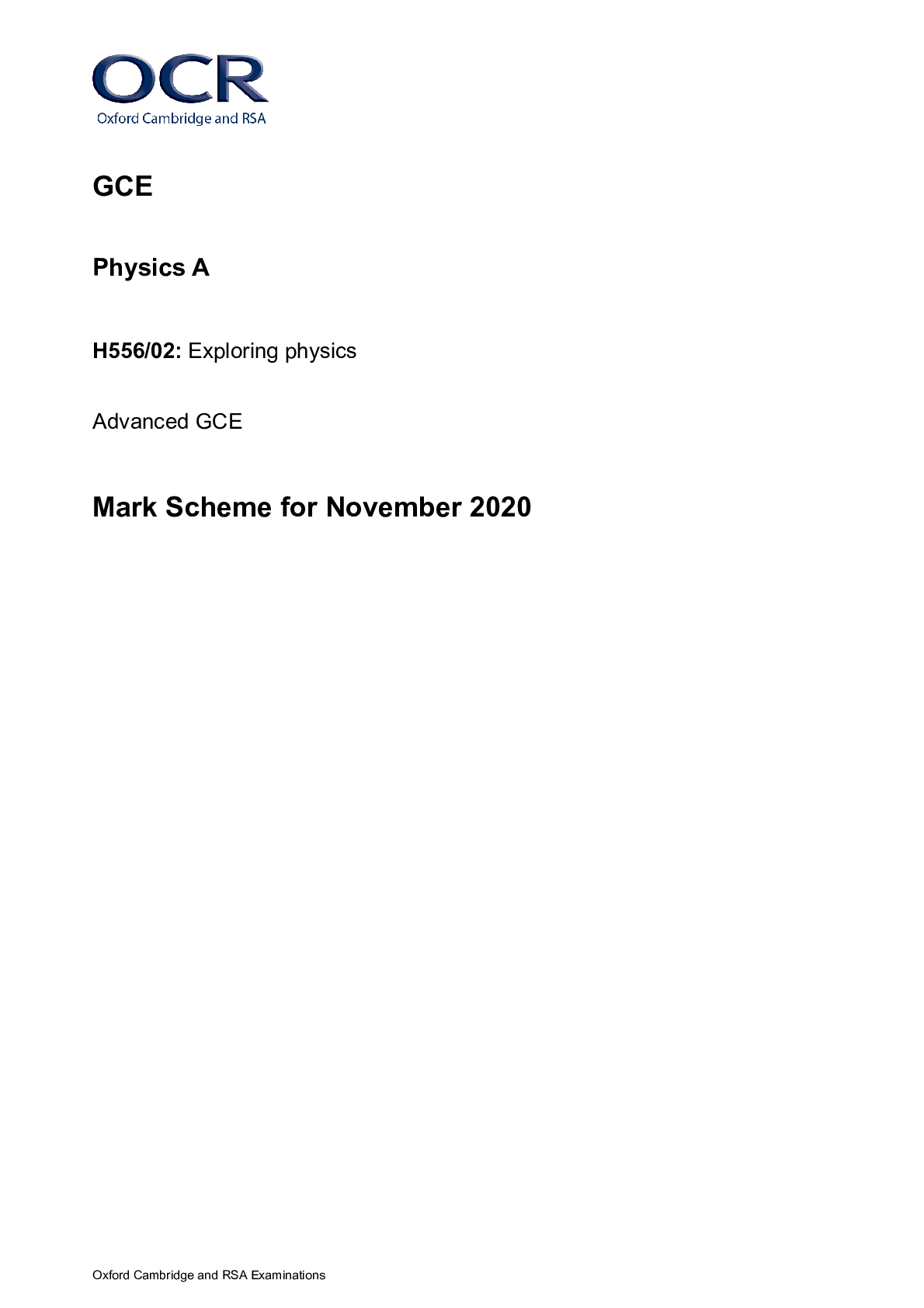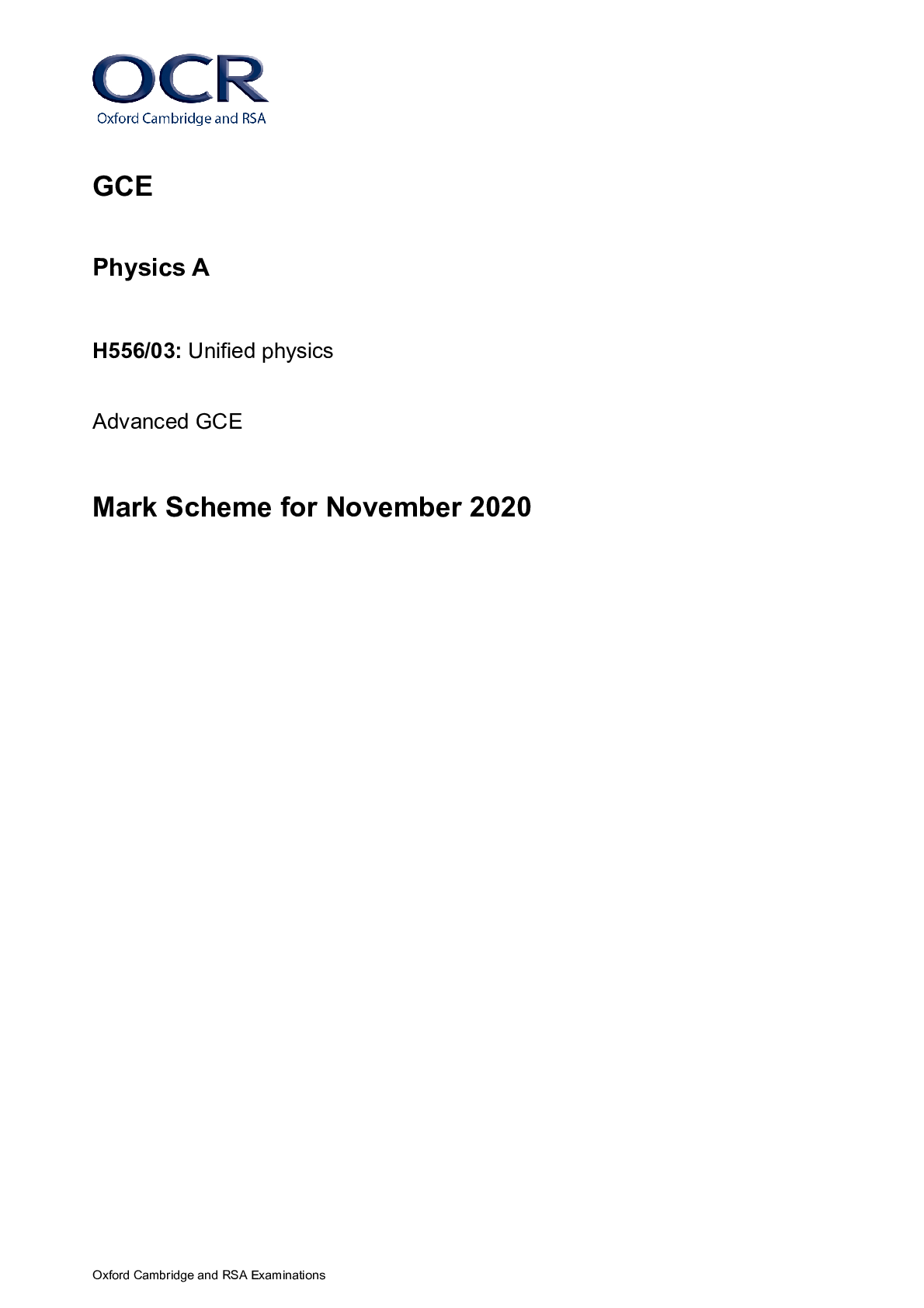Geography > AS Mark Scheme > GCE Geography H481/02: Human interactions Advanced GCE Mark Scheme for Autumn 2021 (All)
GCE Geography H481/02: Human interactions Advanced GCE Mark Scheme for Autumn 2021
Document Content and Description Below
Oxford Cambridge and RSA Examinations GCE Geography H481/02: Human interactions Advanced GCE Mark Scheme for Autumn 2021Oxford Cambridge and RSA Examinations OCR (Oxford Cambridge and RSA) is a ... leading UK awarding body, providing a wide range of qualifications to meet the needs of candidates of all ages and abilities. OCR qualifications include AS/A Levels, Diplomas, GCSEs, Cambridge Nationals, Cambridge Technicals, Functional Skills, Key Skills, Entry Level qualifications, NVQs and vocational qualifications in areas such as IT, business, languages, teaching/training, administration and secretarial skills. It is also responsible for developing new specifications to meet national requirements and the needs of students and teachers. OCR is a not-for-profit organisation; any surplus made is invested back into the establishment to help towards the development of qualifications and support, which keep pace with the changing needs of today’s society. This mark scheme is published as an aid to teachers and students, to indicate the requirements of the examination. It shows the basis on which marks were awarded by examiners. It does not indicate the details of the discussions which took place at an examiners’ meeting before marking commenced. All examiners are instructed that alternative correct answers and unexpected approaches in candidates’ scripts must be given marks that fairly reflect the relevant knowledge and skills demonstrated. Mark schemes should be read in conjunction with the published question papers and the report on the examination. © OCR 2021Mark Scheme October 2021 5 H481/02 1. Annotations Annotation Meaning Highlight Off page comment Omission Unclear or Indicates material for which there is no credit Rubric error placed at start of response not being counted Level 1 Level 2 Level 3 Development of a point Significant amount of material which doesn’t answer the question Used to denote that points had been seen and noted but mostly where credit was given No place specific detail Highlighting an issue e.g. irrelevant paragraph. Use in conjunction with another stamp e.g. or Blank page EvaluationH481/02 Mark Scheme October 2021 6 2. Subject Specific Marking Instructions INTRODUCTION Your first task as an Examiner is to become thoroughly familiar with the material on which the examination depends. This material includes: the specification, especially the assessment objectives the question paper and its rubrics the mark scheme. You should ensure that you have copies of these materials. You should ensure also that you are familiar with the administrative procedures related to the marking process. These are set out in the OCR booklet Instructions for Examiners. If you are examining for the first time, please read carefully Appendix 5 Introduction to Script Marking: Notes for New Examiners. Please ask for help or guidance whenever you need it. Your first point of contact is your Team Leader. USING THE MARK SCHEME Please study this Mark Scheme carefully. The Mark Scheme is an integral part of the process that begins with the setting of the question paper and ends with the awarding of grades. Question papers and Mark Schemes are developed in association with each other so that issues of differentiation and positive achievement can be addressed from the very start. This Mark Scheme is a working document; it is not exhaustive; it does not provide ‘correct’ answers. The Mark Scheme can only provide ‘best guesses’ about how the question will work out, and it is subject to revision after we have looked at a wide range of scripts. The Examiners’ Standardisation Meeting will ensure that the Mark Scheme covers the range of candidates’ responses to the questions, and that all Examiners understand and apply the Mark Scheme in the same way. The Mark Scheme will be discussed and amended at the meeting, and administrative procedures will be confirmed. Co-ordination scripts will be issued at the meeting to exemplify aspects of candidates’ responses and achievements; the co-ordination scripts then become part of this Mark Scheme.H481/02 Mark Scheme October 2021 7 Before the Standardisation Meeting, you should read and mark in pencil a number of scripts, in order to gain an impression of the range of responses and achievement that may be expected. In your marking, you will encounter valid responses which are not covered by the Mark Scheme: these responses must be credited. You will encounter answers which fall outside the ‘target range’ of Bands for the paper which you are marking. Please mark these answers according to the marking criteria. Please read carefully all the scripts in your allocation and make every effort to look positively for achievement throughout the ability range. Always be prepared to use the full range of marks. LEVELS OF RESPONSE QUESTIONS: The indicative content indicates the expected parameters for candidates’ answers, but be prepared to recognise and credit unexpected approaches where they show relevance. Using ‘best-fit’, decide first which set of level descriptors best describes the overall quality of the answer. Once the level is located, adjust the mark concentrating on features of the answer which make it stronger or weaker following the guidelines for refinement. Highest mark: If clear evidence of all the qualities in the level descriptors is shown, the HIGHEST Mark should be awarded. Lowest mark: If the answer shows the candidate to be borderline (i.e. they have achieved all the qualities of the levels below and show limited evidence of meeting the criteria of the level in question) the LOWEST mark should be awarded. Middle mark: This mark should be used for candidates who are secure in the level. They are not ‘borderline’ but they have only achieved some of the qualities in the level descriptors. Be prepared to use the full range of marks. Do not reserve (e.g.) highest level marks ‘in case’ something turns up of a quality you have not yet seen. If an answer gives clear evidence of the qualities described in the level descriptors, reward appropriately. Quality of extended response will be assessed in questions marked with an (*). Quality of extended response is not attributed to any single assessment objective but instead is assessed against the entire response for the question.H481/02 Mark Scheme October 2021 8 AO1 AO2 AO3 Quality of extended response Comprehensive A wide range of detailed and accurate knowledge that demonstrates fully developed understanding that shows full relevance to the demands of the question. Precision in the use of question terminology. Knowledge and understanding shown is consistently applied to the context of the question, in order to form a: clear, developed and convincing analysis that is fully accurate. clear, developed and convincing interpretation that is fully accurate. detailed and substantiated evaluation that offers secure judgements leading to rational conclusions that are evidence based. Quantitative, qualitative and/or fieldwork skills are used in a consistently appropriate and effective way and with a high degree of competence and precision. There is a well-developed line of reasoning which is clear and logically structured. The information presented is relevant and substantiated. Thorough A range of detailed and accurate knowledge that demonstrates welldeveloped understanding that is relevant to the demands of the question. Generally precise in the use of question terminology. Knowledge and understanding shown is mainly applied to the context of the question, in order to form a: clear and developed analysis that shows accuracy. clear and developed interpretation that shows accuracy. detailed evaluation that offers generally secure judgements, with some link between rational conclusions and evidence. Quantitative, qualitative and/or fieldwork skills are used in a suitable way and with a good level of competence and precision. There is a line of reasoning presented with some structure. The information presented is in the most-part relevant and supported by some evidence.H481/02 Mark Scheme October 2021 9 Reasonable Some sound knowledge that demonstrates partially developed understanding that is relevant to the demands of the question. Awareness of the meaning of the terms in the question. Knowledge and understanding shown is partially applied to the context of the question, in order to form a: sound analysis that shows some accuracy. sound interpretation that shows some accuracy. sound evaluation that offers generalised judgements and conclusions, with limited use of evidence. Quantitative, qualitative and/or fieldwork skills are used in a mostly suitable way with a sound level of competence but may lack precision. The information has some relevance and is presented with limited structure. The information is supported by limited evidence. Basic Limited knowledge that is relevant to the topic or question with little or no development. Confusion and inability to deconstruct terminology as used in the question. Knowledge and understanding shows limited application to the context of the question in order to form a: simple analysis that shows limited accuracy. simple interpretation that shows limited accuracy. Un-supported evaluation that offers simple conclusions. Quantitative, qualitative and/or fieldwork skills are used inappropriately with limited competence and precision. The information is basic and communicated in an unstructured way. The information is supported by limited evidence and the relationship to the evidence may not be clear.H481/02 Mark Scheme October 2021 10 Question Answer Mark Guidance 1 (a) Study Fig.1, which shows employment share by sector for Glasgow in 1971 and 2015. Use one piece of evidence from Fig.1 to explain the influence of globalisation on structural economic change. employment in secondary industry decreased from 31% to 7% () advances in transport technology, such as bulk handling and containerisation, enable goods to be moved more cheaply around the globe (DEV) contributing to deindustrialisation / loss of manufacturing in ACs to LIDCs and EDCs (DEV) employment in tertiary and quaternary sectors increased from 67% to 92% () [tertiary 58%- 67% () / quaternary 9%-25% ()] advances in communications technology have improved interconnections / interdependence (DEV) and rise of service industry / hubs in ACs (DEV) overall employment decline in primary and secondary sectors (33%-8%) and growth in tertiary and quaternary sectors () demonstrates structural economic change which is part of global shift / NIDL (DEV) role of TNCs and nation states in driving economic change across the globe (DEV) 3 AO2 x2 AO3 x1 AO2 – 2 marks AO3 – 1 mark 1 x 1 () for specific evidence interpreted from the resource. 2 x 1 (DEV) for drawing conclusions from specific resource evidence to explain the influence of globalisation on structural economic change. 1 (b) Study Fig. 2, which shows percentage of primary pupils eligible for free school meals in the West Midlands, 2017. Using evidence from Fig. 2, suggest factors that might explain the spatial pattern of social inequality shown. 8 AO2 x4 AO3 x4 Indicative content AO2 – 4 marks Eligibility for free school meals (eFSM) is an index of social inequality. Application can be made by households which receive any government benefit such as Income Support, Jobseeker’s Allowance or Universal Credit.H481/02 Mark Scheme October 2021 11 Level 3 (6-8 marks) Application of knowledge and understanding is thorough. Analysis of the spatial pattern of social inequality is clear, developed and accurate (AO2). Demonstrates thorough investigation of the choropleth map to fully evidence the spatial pattern of social inequality. Ideas about the spatial pattern of social inequality are good (AO3). Level 2 (3-5 marks) Application of knowledge and understanding is reasonable. Analysis of the spatial pattern of social inequality is sound and accurate (AO2). Demonstrates reasonable investigation of the choropleth map to fully evidence the spatial pattern of social inequality. Ideas about the spatial pattern of social inequality are sound (AO3). Level 1 (1-2 marks) Application of knowledge and understanding is basic. Analysis of the spatial pattern of social inequality is basic and accurate (AO2). Demonstrates basic investigation of the choropleth map providing limited evidence of the spatial pattern of social inequality. Ideas about the spatial pattern of social inequality are limited, with limited or no link to resource evidence (AO3). 0 marks No response or no response worthy of credit. Application of knowledge and understanding to analyse the spatial pattern of social inequality of primary pupils eligible for free school meals could potentially include factors such as: income – higher %s of eFSM where household income is low or irregular, for example in areas of higher levels of unemployment, or where parents have limited qualifications and are in low-skilled jobs. employment – higher % of eFSM where higher levels of unemployment / industrial decline / families claiming universal credit and other benefits, possibly highest concentrations in urban neighbourhoods / estates. Contrasting with areas of lower unemployment such as some outer suburbs / commuter villages / areas of economic growth housing – higher %s of eFSM where housing is more affordable / rents are lower, possibly inner city areas of terraced housing / flats deprivation – higher %s of eFSM where families live in areas of multiple deprivation / interrelated factors contributing to poverty such as poor educational attainment, low incomes, higher unemployment, poor physical and mental health relative poverty – higher %s of eFSM where children live in relative income poverty (income below 60% of the household median). Child poverty is high in particular urban areas / neighbourhoods where there is multiple deprivation, less so in urban and rural areas where standard of living and quality of life are higher.H481/02 Mark Scheme October 2021 12 AO3 - 4 marks Evidence from investigation and interpretation of the choropleth map could potentially include: uneven pattern within the West Midlands Metropolitan County between the Metropolitan Boroughs such as Birmingham 25.5%, Walsall 20.8%, Coventry 15.1% and Dudley 14.6% overall pattern of higher %s in the Metropolitan County and lower %s in the peripheral counties marked contrasts within the West Midlands Metropolitan County between Metropolitan Boroughs such as Birmingham 25.5% and Solihull 12.9% marked contrasts between the more urban boroughs such as Wolverhampton 20.3% and the more rural counties such as Staffordshire 9.4% 1 (c) Explain how people’s behaviour and activity in a place can be influenced by their level of emotional attachment to it. Level 3 (5-6 marks) Demonstrates thorough knowledge and understanding of how people’s behaviour and activity in a place can be influenced by their level of emotional attachment to it. This will be shown by including well-developed ideas about the links between behaviour and activity in a place and level of emotional attachment. Level 2 (3-4 marks) Demonstrates reasonable knowledge and understanding of how people’s behaviour and activity in a place can be influenced by their level of emotional attachment to it. This will be shown by including developed ideas about 6 AO1 x6 Indicative content AO1 – 6 marks Knowledge and understanding of how people’s behaviour and activity in a place can be influenced by their level of emotional attachment to it could potentially include: attachment of national groups (without a state) to their heartland, such as the Basque nation. They have developed a cultural identity to their home area including language, food, customs and political autonomy. In the past they have used forceful / violent and peaceful protests in their claims for independence. attachment of local community residents to their neighbourhood. Emotional attachment to their residential area can promote and encourage environmentally responsible behaviour; forH481/02 Mark Scheme October 2021 13 the links between behaviour and activity in a place and level of emotional attachment. Level 1 (1-2 marks) Demonstrates basic knowledge and understanding of how people’s behaviour and activity in a place can be influenced by their level of emotional attachment to it. There may be simple ideas about the links between behaviour and activity in a place and level of emotional attachment. 0 marks No response or no response worthy of credit. example, tending green spaces such as urban parks for use by families for recreation / leisure activities and developing positive social interaction between neighbours. attachment of diaspora communities to an adopted area such as established by ethnic groups in UK cities. They have maintained national identity in communities, preserving language, dress, food, cultural activities plus developing religious buildings, retail and services. attachment of individuals and families to a holiday destination, sports stadium, or place of education for example, encourages repeated return visits for recreational activities / supporting a team / reunions. none or little emotional attachment to a place such as an area of dereliction - anti-social behaviour, environmental damage. Behaviour and / or activity may be awarded full marks. 1 (d)* To what extent do present-day connections shape the identity of a place? AO1 Level 3 (6–8 marks) Demonstrates thorough knowledge and understanding of present-day connections and other factors that shape the identity of a place. The answer should include accurate place-specific detail. Level 2 (3–5 marks) Demonstrates reasonable knowledge and understanding of present-day connections and other factors that shape the identity of a place. The answer should include some place-specific detail which is partially accurate. 16 AO1 x8 AO2 x8 Indicative content AO1 – 8 marks Knowledge and understanding of present-day connections and other factors that shape the identity of a place could potentially include: present-day connections o flows of people including journey to work, retail allegiances, student links, migration o access to services o trade links, movement of goods in / out of a place o multi-cultural links o investments o flows of ideas o access to natural resourcesH481/02 Mark Scheme October 2021 14 Level 1 (1–2 marks) Demonstrates basic knowledge and understanding of present-day connections and other factors that shape the identity of a place. There is an attempt to include place-specific detail but it is inaccurate. 0 marks No response or no response worthy of credit. AO2 Level 3 (6–8 marks) Application of knowledge and understanding is thorough. Analysis is clear, developed and accurate. Evaluation of present-day connections and other factors that shape the identity of a place is detailed. Judgements are secure and evidence based leading to rational conclusions. Level 2 (3–5 marks) Application of knowledge and understanding is reasonable. Analysis is sound and shows some accuracy. Evaluation of present-day connections and other factors that shape the identity of a place is sound. Judgements and conclusions are generalised, with limited use of evidence. Level 1 (1–2 marks) Application of knowledge and understanding is basic. Analysis is simple and limited in accuracy. Evaluation of present-day connections and other factors that shape the identity of a place is un-supported and conclusions are simple. 0 marks No response or no response worthy of credit. past connections o movements of people such as Roman, Saxon, other ethnic groups and their cultural influences o access to natural resources such as marine/geological o trade links and related buildings and industry other factors contributing to place identity o natural characteristics o demographic structure o political decisions o impact of planners and architects on urban and rural environments AO2 – 8 marks Application of knowledge and understanding to analyse and evaluate present-day connections and other factors that shape the identity of a place could potentially include: the idea that connections at different scales, from local to global, are embedded in the identity of a place evaluation of the relative importance of presentday connections, past connections and other factors that shape the identity of a place the idea that present-day connections, past connections and other factors interact to shape the identity of a place the idea that the identity of a place can change over time as the various influences (connections and other factors) also change in significance Place-specific detail could be related to a case study of one place or to case studies of contrasting places.H481/02 Mark Scheme October 2021 15 Quality of extended response Level 3 There is a well-developed line of reasoning which is clear and logically structured. The information presented is relevant and substantiated. Level 2 There is a line of reasoning presented with some structure. The information presented is in the most-part relevant and supported by some evidence. Level 1 Information is basic and communicated in an unstructured way. The information is supported by limited evidence and the relationship to the evidence may not be clear.H481/02 Mark Scheme October 2021 16 Question Answer Mark Guidance 2* ‘Advanced countries benefit the most from the opportunities created by international trade.’ How far do you agree? AO1 Level 3 (6–8 marks) Demonstrates thorough knowledge and understanding of opportunities created by international trade in ACs and other countries. The answer should include accurate place-specific detail. Level 2 (3–5 marks) Demonstrates reasonable knowledge and understanding of opportunities created by international trade in ACs and other countries. The answer should include some place-specific detail which is partially accurate. Level 1 (1–2 marks) Demonstrates basic knowledge and understanding of opportunities created by international trade in ACs and other countries. There is an attempt to include placespecific detail but it is inaccurate. 0 marks No response or no response worthy of credit. AO2 Level 3 (6–8 marks) Application of knowledge and understanding is thorough. Analysis is clear, developed, convincing and accurate. Evaluation of opportunities and associated benefits created by international trade in ACs and other countries is detailed and substantiated. Judgements are 16 AO1 x8 AO2 x8 Indicative content AO1 – 8 marks Knowledge and understanding of opportunities created by international trade in ACs and other countries, could potentially include: Opportunities created by international trade for ACs sustained economic growth as a result of further investment (domestic and FDI) stimulation of the economic multiplier employment opportunities ability to integrate other countries into global supply chains such as LIDCs and EDCs development of positive political and cultural relationships with trade partners including environmental stewardship strong position to develop wider range of bi- and multi-lateral trade agreements / partnership Opportunities created by international trade for LIDCs and other countries economic development generation of GDP diversification of economic activity investment in infrastructure investment in health and education create employment opportunities contribute to development such as reduce social inequality, improve human rights, reduce crime and conflict, contribute to political stability benefit from corporate social responsibilities of TNCs strengthen interdependence / develop trade partnershipsH481/02 Mark Scheme October 2021 17 secure and evidence based leading to rational conclusions as to whether ACs benefit the most. Level 2 (3–5 marks) Application of knowledge and understanding is reasonable. Analysis is clear, developed and shows accuracy. Evaluation of opportunities and associated benefits created by international trade in ACs and other countries is detailed. Judgements are generally secure with some link between rational conclusions as to whether ACs benefit the most and evidence. Level 1 (1–2 marks) Application of knowledge and understanding is basic. Analysis is simple and shows limited accuracy. Evaluation of opportunities and associated benefits created by international trade in ACs and other countries is un-supported and offers simple conclusions as to whether ACs benefit the most. 0 marks No response or no response worthy of credit. Quality of extended response Level 3 There is a well-developed line of reasoning which is clear and logically structured. The information presented is relevant and substantiated. Level 2 There is a line of reasoning presented with some structure. The information presented is in the most-part relevant and supported by some evidence. Level 1 Information is basic and communicated in an unstructured way. The information is supported by limited evidence and the relationship to the evidence may not be clear. AO2 – 8 marks Application of knowledge and understanding to analyse and evaluate opportunities created by international trade in ACs and other countries, could potentially include: evaluation of opportunities in ACs relative to those in other countries, such as LIDCs opportunities can be economic, social, environmental, political opportunities can be for governments, industries, households opportunities can be derived at different scales (spatial, temporal, numbers affected) from local to national ACs already have many benefits derived from their trade such as diversified economy, economic wealth. LIDCs might be able to gain much more in relative terms since they are at a lower economic base, many being poor, with limited industrial diversity core economies / ACs are in a strong position to drive trade / establish trade partners whereas peripheral economies / LIDCs can only respond to change in the global trade system reference to relative impacts of challenges presented by international trade Place-specific detail could be drawn from any instances of trade in ACs, such as USA, LIDCs, such as Sierra Leone or EDCs, such as India.H481/02 Mark Scheme October 2021 18 Question Answer Mark Guidance 3* ‘Advanced countries benefit the most from the opportunities created by international migration.’ How far do you agree? AO1 Level 3 (6–8 marks) Demonstrates thorough knowledge and understanding of opportunities created by international migration in ACs and other countries. The answer should include accurate place-specific detail. Level 2 (3–5 marks) Demonstrates reasonable knowledge and understanding of opportunities created by international migration in ACs and other countries. The answer should include some place-specific detail which is partially accurate. Level 1 (1–2 marks) Demonstrates basic knowledge and understanding of opportunities created by international migration in ACs and other countries. There is an attempt to include place-specific detail but it is inaccurate. 0 marks No response or no response worthy of credit. AO2 Level 3 (6–8 marks) Application of knowledge and understanding is thorough. Analysis is clear, developed and convincing and accurate. Evaluation of opportunities and associated benefits created by international migration in ACs and other countries is detailed and substantiated. 16 AO1 x8 AO2 x8 Indicative content AO1 – 8 marks Knowledge and understanding of opportunities created by international migration in ACs and other countries, could potentially include: Opportunities created by international migration for ACs addresses labour shortages in both low-skilled and highly skilled jobs contribution to GDP and economic growth contribution to tax base demographic effects such as stimulating population growth in countries of ageing population stimulates local economic multiplier effects since migrants are themselves consumers and in time potential investors Opportunities created by international migration for LIDCs and other countries stimulates economic co-operation with other countries, especially where bi-lateral links are strengthened, which can help development projects flows of migrant remittances, financial and social, can have local and national impacts can stimulate political co-operation between countries, contributing to political stability and co-operation over issues such as traffickingH481/02 Mark Scheme October 2021 19 Judgements are secure and evidence based leading to rational conclusions as to whether ACs benefit the most. Level 2 (3–5 marks) Application of knowledge and understanding is reasonable. Analysis is clear, developed and shows accuracy. Evaluation of opportunities and associated benefits created by international migration in ACs and other countries is detailed. Judgements are generally secure with some link between rational conclusions as to whether ACs benefit the most and evidence. Level 1 (1–2 marks) Application of knowledge and understanding is basic. Analysis is simple and shows limited accuracy. Evaluation of opportunities and associated benefits created by international migration in ACs and other countries is un-supported and offers simple conclusions as to whether ACs benefit the most. 0 marks No response or no response worthy of credit. Quality of extended response Level 3 There is a well-developed line of reasoning which is clear and logically structured. The information presented is relevant and substantiated. Level 2 There is a line of reasoning presented with some structure. The information presented is in the most-part relevant and supported by some evidence. Level 1 Information is basic and communicated in an unstructured way. The information is supported by limited evidence and the relationship to the evidence may not be clear. AO2 – 8 marks Application of knowledge and understanding to analyse and evaluate opportunities created by international migration in ACs and other countries could potentially include: evaluation of opportunities in ACs relative to those in other countries, such as LIDCs opportunities can be economic, social, environmental, political opportunities can be for governments, industries / employers, households opportunities can be derived at different scales (spatial, temporal, numbers affected) from local to national ACs already have many benefits derived from international migration such as labour supply and other economic and social contributions. LIDCs might be able to gain much more in relative terms since they are at a lower economic base. core economies / ACs are in a strong position to encourage or limit migration often selectively, whereas peripheral economies / LIDCs can only respond to change in the global migration system. reference to relative impacts of challenges presented by international migration Place-specific detail could be drawn from any instances of migration in ACs, such as USA, LIDCs, such as Laos or EDCs, such as Brazil.H481/02 Mark Scheme October 2021 20 Question Answer Mark Guidance 4 (a) (i) Study Fig. 3, which shows Maternal Mortality Rates for selected countries, 2018. Find the value of the mean for the data in Fig. 3. You must show your working. 282 () (5+9+14+174+396+587+789) / 7 (DEV) 2 AO3 x2 AO3 – 2 marks 1 x 1 mark () for correct answer. 1 x 1 mark (DEV) for showing correct working. 4 (a) (ii) Give one advantage and one disadvantage of using the mean to describe this data. Advantages: the mean is based on mathematical principles - the calculation uses all the statistics in the distribution the mean can be used to calculate other related statistics such as the standard deviation the mean can be used for comparison with the mean MMR of other selected countries the mean is widely used, commonly understood and easy to calculate Disadvantages: the mean does not give any indication of the range of values in this distribution the mean MMR for a set of other countries could be very similar but it is possible that this might describe a very different distribution / data set the mean does not represent this data set very accurately since the distribution is skewed by the number of high values 2 AO3 x2 AO3 – 2 marks 1 x 1 mark () for identifying an appropriate advantage of using the mean to describe the data in Fig. 3. 1 x 1 mark () for identifying an appropriate disadvantage of using the mean to describe the data in Fig.3.H481/02 Mark Scheme October 2021 21 4 (b) Suggest two factors that might account for global variation in maternal mortality rates. Level 2 (3-5 marks) Application of knowledge and understanding is thorough. Analysis of factors that explain global variation in MMR is sound and shows accuracy. Level 1 (1-2 marks) Application of knowledge and understanding is basic. Analysis of factors that explain global variation in MMR is simple and there is limited accuracy. 0 marks No response or no response worthy of credit. 5 AO2 x5 AO2 – 5 marks Application of knowledge and understanding to analyse factors that explain global variation in MMR could potentially include: access to treatment for pregnancy and birth complications, especially emergency care quality of medical services, especially provision of skilled attendance at birth level of political commitment and government investment availability of information and education, especially of women cultural barriers which affect discrimination poverty of governments and households 4 (c) With reference to a case study of an LIDC, assess the challenges for global governance of human rights. Level 3 (6–8 marks) Demonstrates thorough knowledge and understanding of the challenges for global governance of human rights in an LIDC. This will be shown by including welldeveloped explanations. The answer should include accurate place-specific detail. Level 2 (3–5 marks) Demonstrates reasonable knowledge and understanding of the challenges for global governance of human rights in an LIDC. This will be shown by including developed explanations. The answer should include some place-specific detail which is partially accurate. 8 AO1 x8 Indicative content AO1 – 8 marks Global governance of human rights involves interventions by the UN, NGOs, other CSOs and regional organisations. Knowledge and understanding of the challenges for global governance of human rights in an LIDC could potentially include inequalities and / or injustices such as: socio-economic inequalities for example within urban areas / between urban and rural areas – complex challenges for supply of housing / water / sanitation / health care / education rural-urban migration and squatter settlement growth – rapidly changing – hinders coordination of strategies impact of external out-migration on demographic structure / workforce / brain drainH481/02 Mark Scheme October 2021 22 Level 1 (1–2 marks) Demonstrates basic knowledge and understanding of the challenges for global governance of human rights in an LIDC. This will be shown by including simple explanations. There is an attempt to include place-specific detail but it is inaccurate. 0 marks No response or no response worthy of credit. gender inequalities, for example entrenched in patriarchal societies – restrict strategies of cooperation inadequate state apparatus, for example judicial system / corrupt police – restricts enforcement of rule of law national government unable to restrict organised crime, including, drug trafficking, urban gangs – limits co-operation of local communities and NGOs pervasive discrimination / violence in society, especially affecting women – difficult to build a stronger human rights culture Reference to a case study must be included; there is no requirement for a candidate to make reference to more than one case study.H481/02 Mark Scheme October 2021 23 5 (a) (i) Study Fig. 4, which shows the State Fragility Index for selected countries, 2018. Find the value of the mean for the data in Fig. 4. You must show your working. 69.7 () (25.8+34.5+37.7+76.3+93.6+106.6+113.4) / 7 (DEV) 2 AO3 x2 AO3 – 2 marks 1 x 1 mark () for correct answer. 1 x 1 mark (DEV) for showing correct working. . 5 (a) (ii) Give one advantage and one disadvantage of using the mean to describe this data. Advantages: the mean is based on mathematical principles - the calculation uses all the statistics in the distribution the mean can be used to calculate other related statistics such as the standard deviation the mean can be used for comparison with the mean State Fragility of other selected countries the mean is widely used, commonly understood and easy to calculate Disadvantages: the mean does not give any indication of the range of values in this distribution the mean State Fragility for a set of other countries could be very similar but it is possible that this might describe a very different distribution / data set the mean does not represent this data set very accurately since the distribution is skewed by the number of high values 2 AO3 x2 AO3 – 2 marks 1 x 1 mark () for identifying an appropriate advantage of using the mean to describe the data in Fig.4. 1 x 1 mark () for identifying an appropriate disadvantage of using the mean to describe the data in Fig.4. Question Answer Mark GuidanceH481/02 Mark Scheme October 2021 24 5 (b) Suggest two ways that current political boundaries might have an influence on the erosion of sovereignty. Level 2 (3-5 marks) Application of knowledge and understanding is thorough. Analysis of ways that current political boundaries influence erosion of sovereignty is sound and shows accuracy. Level 1 (1-2 marks) Application of knowledge and understanding is basic. Analysis of ways that current political boundaries influence erosion of sovereignty is simple and there is limited accuracy. 0 marks No response or no response worthy of credit. 5 AO2 x5 AO2 – 5 marks Application of knowledge and understanding to analyse ways that current political boundaries influence erosion of sovereignty could potentially include: legacy of colonialism: partition of ethnic groups by arbitrary colonial boundaries, causing conflict with national governments such as in Mali separatism / claims for secession: politically dominant national groups seeking independence, such as Catalan nationalism, where homeland boundaries do not coincide with current national boundaries contested territory: challenges to territorial integrity such as annexation of Crimea, or contested islands in South and East China Seas contested land / maritime boundaries: where resources, such as Kashmir water supply, and exploration rights such as offshore West African oil reserves are disputed 5 (c) With reference to a case study of an LIDC, assess the challenges for global governance of either sovereignty or territorial integrity. Level 3 (6–8 marks) Demonstrates thorough knowledge and understanding of the challenges for global governance of sovereignty / territorial integrity of an LIDC. This will be shown by including well-developed explanations. The answer should include accurate place-specific detail. Level 2 (3–5 marks) Demonstrates reasonable knowledge and understanding of the challenges for global governance of sovereignty / territorial integrity of an LIDC. This will be shown by including developed explanations. The answer should include some place-specific detail which is partially accurate. 8 AO1 x8 Indicative content AO1 – 8 marks Global governance of sovereignty / territorial integrity involves interventions by the UN, NGOs, other CSOs and regional organisations. Knowledge and understanding of the challenges for global governance of sovereignty / territorial integrity of an LIDC could potentially include problems created by inequalities and / or injustices such as: deep-rooted cultural / linguistic divisions within an LIDC - hinder peace making inequalities, such as urban-rural (infrastructure / services) - limiting factor in co-ordination of strategies inequality in political representation on basis of ethnicity / gender / geographical area - restrict co-operation between ethnic groups and national governmentH481/02 Mark Scheme October 2021 25 Level 1 (1–2 marks) Demonstrates basic knowledge and understanding of the challenges for global governance of sovereignty / territorial integrity of an LIDC. This will be shown by including simple explanations. There is an attempt to include place-specific detail but it is inaccurate. 0 marks No response or no response worthy of credit. government inability to police its own country government inability to protect its own people from human rights abuse / persistent human rights issues such as high MMR/IMR impact of civil war, terrorism, land mines, - restrict movement of aid workers / NGOs / UN peacekeepers lack of co-operation / obstruction by the national government Sovereignty and territorial integrity are not mutually exclusive; reference to either or both where linked in a case study may be awarded full marks. Reference to a case study must be included; there is no requirement for a candidate to make reference to more than one case study.OCR (Oxford Cambridge and RSA Examinations) The Triangle Building Shaftesbury Road Cambridge CB2 8EA [Show More]
Last updated: 1 year ago
Preview 1 out of 24 pages
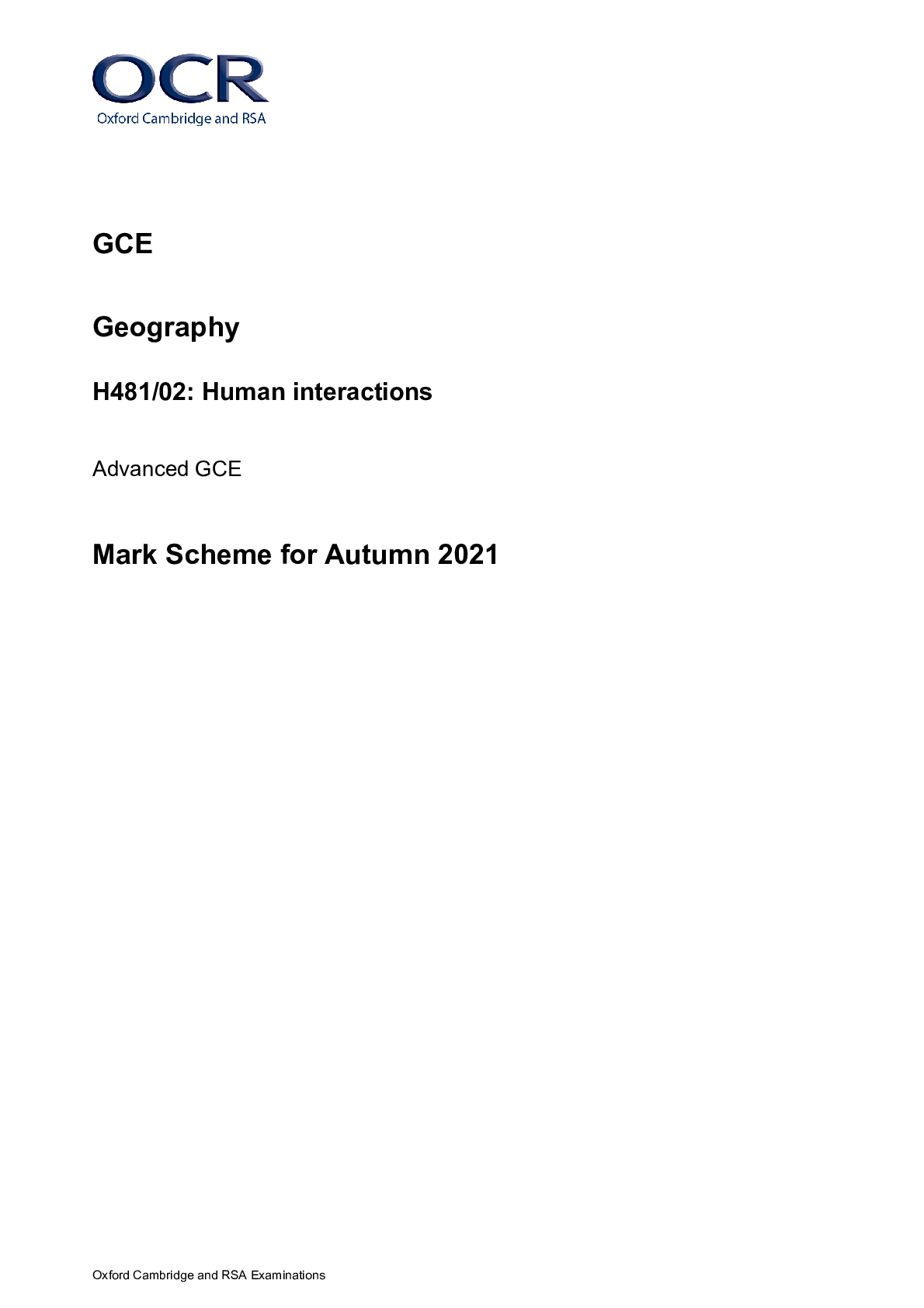
Buy this document to get the full access instantly
Instant Download Access after purchase
Add to cartInstant download
We Accept:

Reviews( 0 )
$7.50
Document information
Connected school, study & course
About the document
Uploaded On
Oct 10, 2022
Number of pages
24
Written in
Additional information
This document has been written for:
Uploaded
Oct 10, 2022
Downloads
0
Views
69

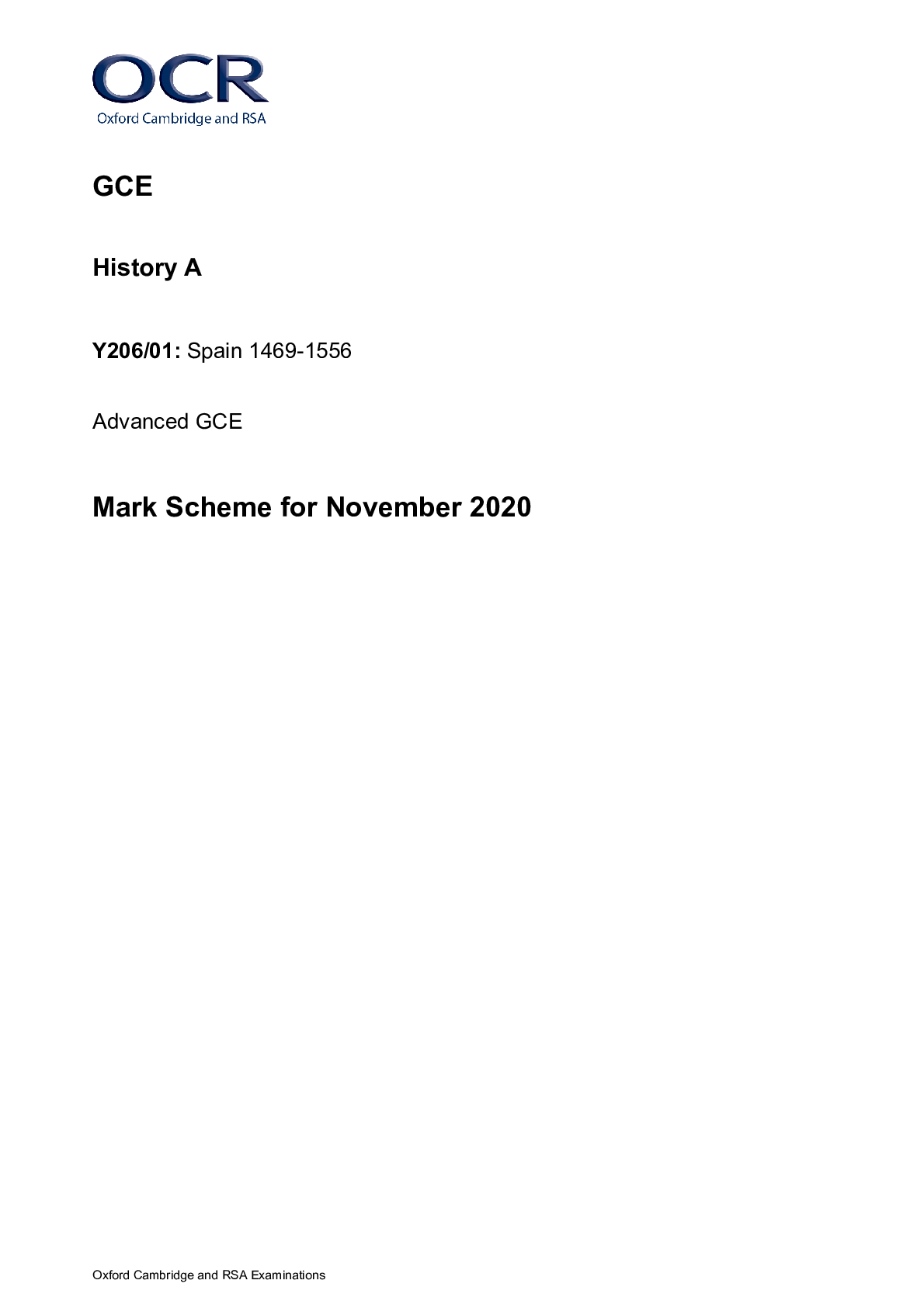
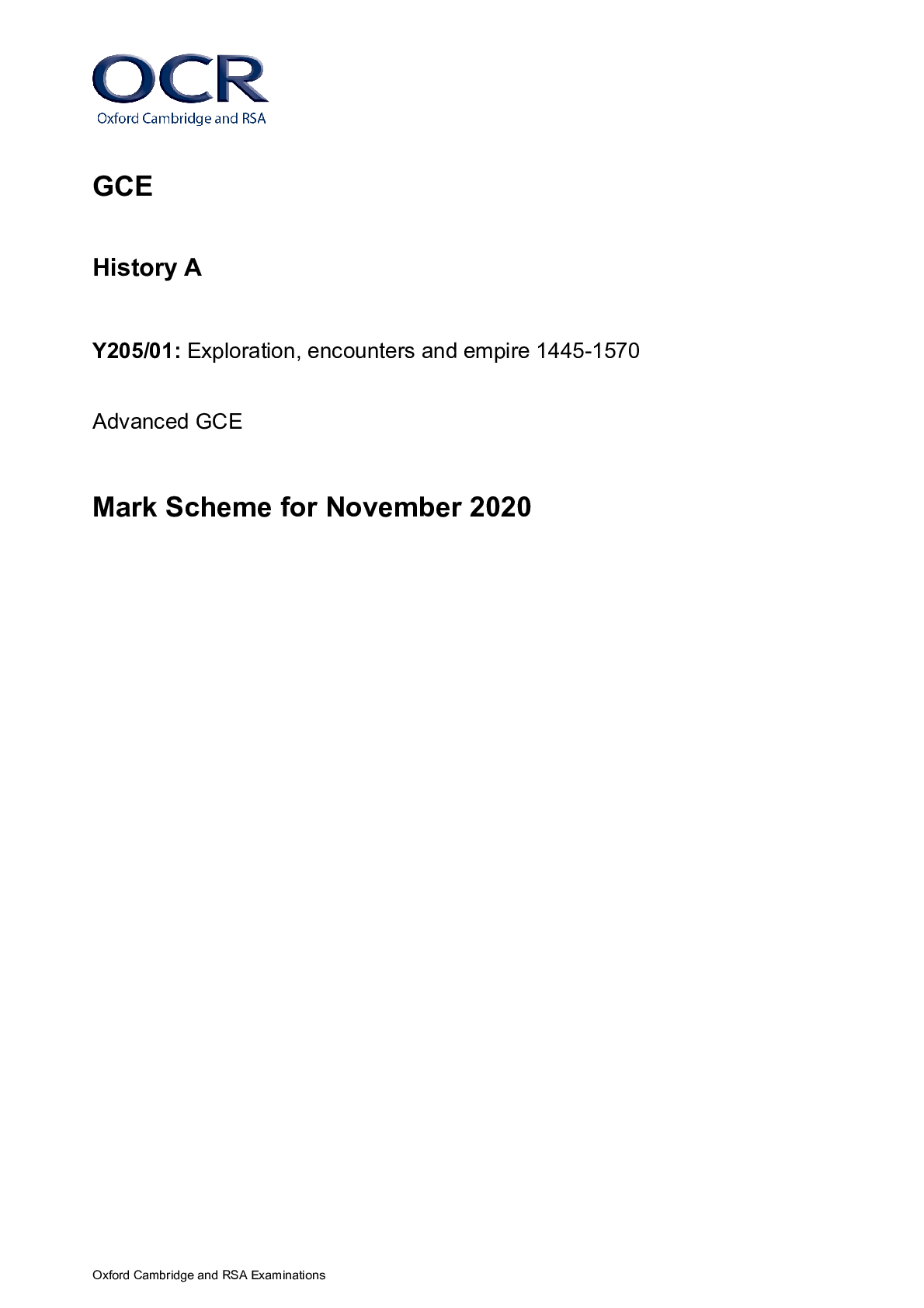






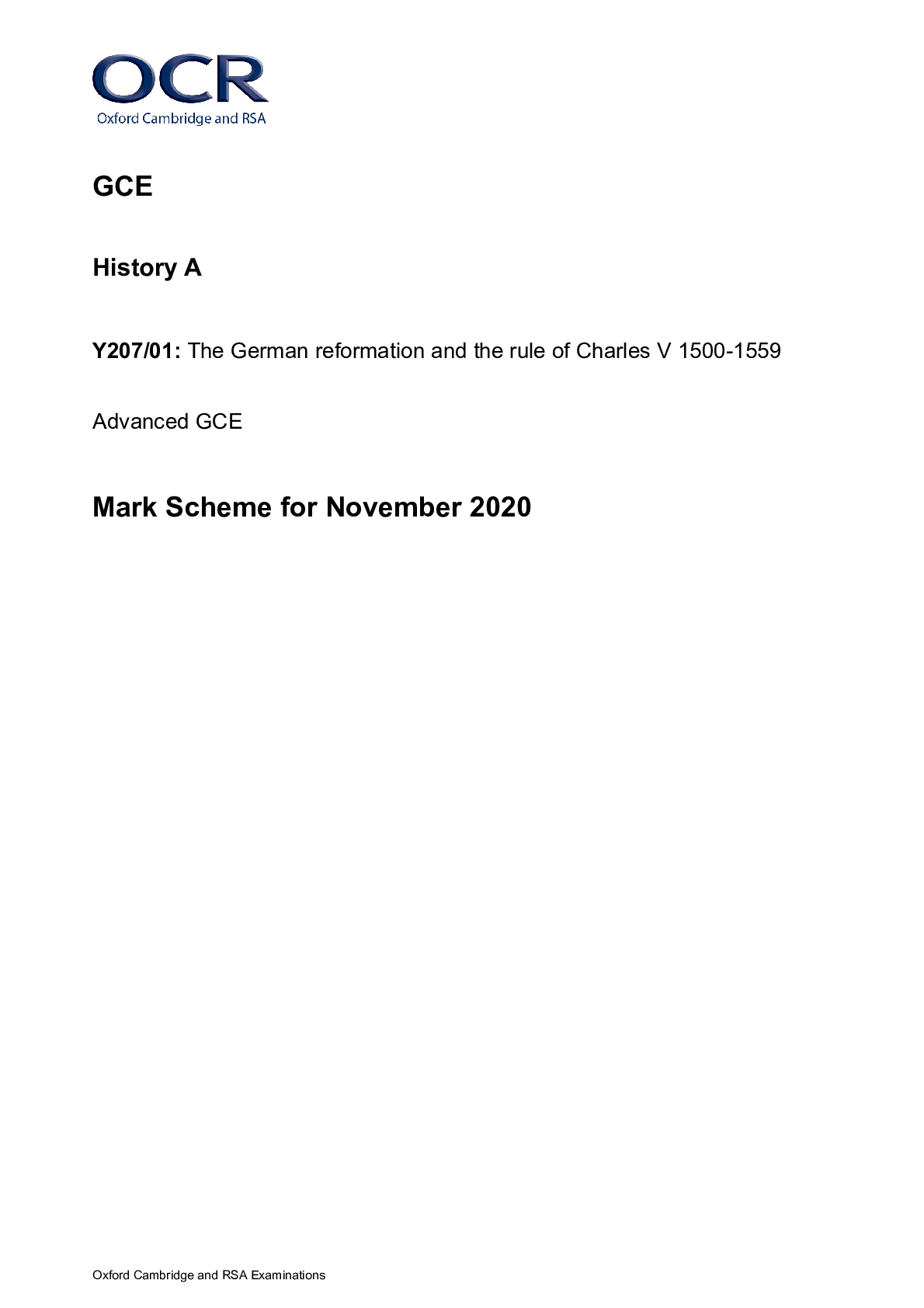






.png)


